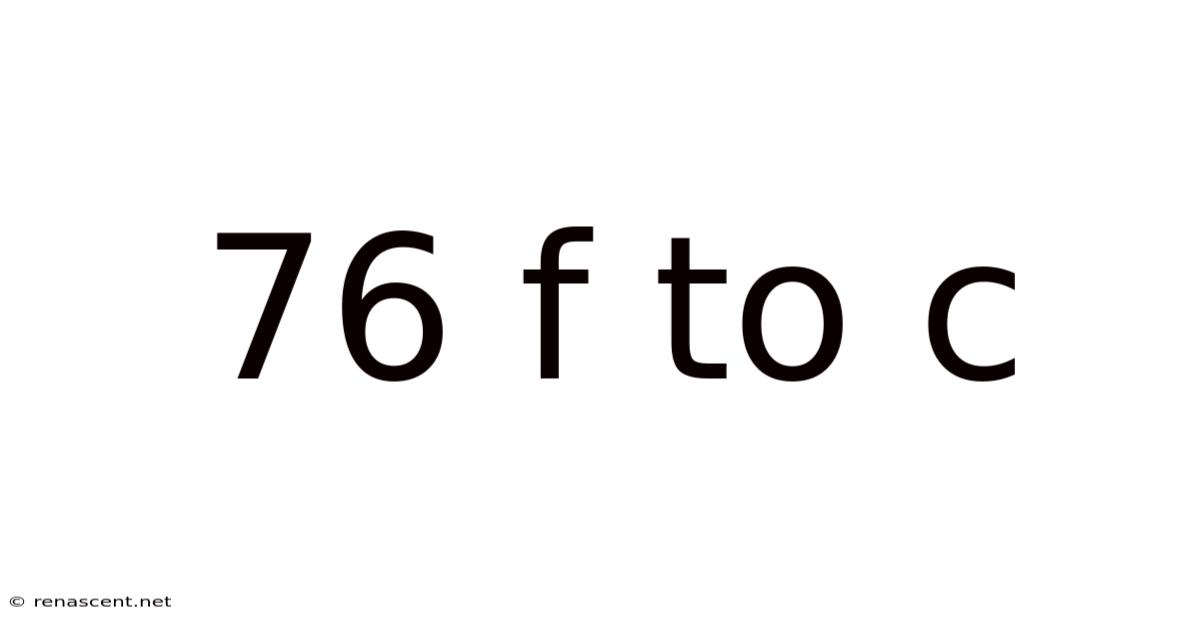76 F To C
renascent
Sep 14, 2025 · 5 min read

Table of Contents
Decoding 76°F to °C: A Comprehensive Guide to Fahrenheit-Celsius Conversion
Understanding temperature conversions is crucial in various fields, from cooking and meteorology to engineering and medicine. This comprehensive guide will delve into the conversion of 76° Fahrenheit (°F) to Celsius (°C), explaining the process, the underlying science, and providing practical applications. We'll also address frequently asked questions and explore the broader context of temperature scales. By the end, you'll not only know the answer to "76 F to C" but also grasp the fundamental principles behind temperature conversion.
Understanding Fahrenheit and Celsius Scales
Before diving into the conversion, let's briefly review the two temperature scales: Fahrenheit (°F) and Celsius (°C). These are the two most commonly used scales globally, although Kelvin (K) is the standard in scientific contexts.
-
Fahrenheit (°F): This scale, developed by Daniel Gabriel Fahrenheit in the early 18th century, defines the freezing point of water as 32°F and the boiling point as 212°F at standard atmospheric pressure. It's predominantly used in the United States and a few other countries.
-
Celsius (°C): Also known as the centigrade scale, Celsius (°C) was developed by Anders Celsius. It sets the freezing point of water at 0°C and the boiling point at 100°C at standard atmospheric pressure. It's the most widely used scale globally, favored for its simplicity and logical structure.
The key difference lies in the size of the degree increments and the chosen reference points. Understanding this difference is fundamental to performing accurate conversions.
Calculating 76°F to °C: The Conversion Formula
The conversion from Fahrenheit to Celsius involves a straightforward formula:
°C = (°F - 32) × 5/9
Let's apply this formula to convert 76°F:
°C = (76 - 32) × 5/9 = 44 × 5/9 = 220/9 ≈ 24.44°C
Therefore, 76°F is approximately equal to 24.44°C.
A Step-by-Step Guide to Fahrenheit-Celsius Conversion
For those who prefer a more detailed breakdown, here’s a step-by-step guide:
-
Subtract 32: Begin by subtracting 32 from the Fahrenheit temperature. In our case, 76°F - 32°F = 44°F. This step adjusts for the difference in the freezing points of the two scales.
-
Multiply by 5/9: Next, multiply the result from step 1 by 5/9. This accounts for the different sizes of the degree increments between Fahrenheit and Celsius. 44°F × (5/9) = 220/9 ≈ 24.44°C.
-
Interpret the Result: The final result, approximately 24.44°C, represents the equivalent temperature in Celsius.
The Scientific Basis of Temperature Conversion
The conversion formula isn't arbitrary; it reflects the relationship between the scales' defining points. The factor 5/9 arises because there are 180 degrees between the freezing and boiling points of water on the Fahrenheit scale (212°F - 32°F = 180°F) and 100 degrees on the Celsius scale. The ratio 180/100 simplifies to 9/5, and its reciprocal, 5/9, is used in the conversion formula.
Practical Applications of Fahrenheit-Celsius Conversion
Understanding temperature conversion is essential in numerous everyday scenarios and professional contexts:
-
Cooking: Many recipes provide temperatures in either Fahrenheit or Celsius. Accurate conversion ensures the correct cooking temperature is achieved.
-
Weather Forecasting: Weather reports often present temperatures in both scales, necessitating conversion for accurate understanding.
-
Medicine: Body temperature is frequently measured in both Fahrenheit and Celsius. Correct conversion ensures appropriate medical responses.
-
Engineering and Science: Precise temperature measurements are critical in engineering and scientific experiments. Conversion between scales allows for consistent data reporting and analysis.
-
International Travel: Familiarity with both scales is crucial when traveling internationally, as different regions use different temperature scales.
Frequently Asked Questions (FAQ)
Q: Is there an easy way to approximate the conversion?
A: A rough approximation can be achieved by subtracting 30 from the Fahrenheit temperature and then dividing the result by 2. While not perfectly accurate, it offers a quick estimate. For 76°F, this method yields (76-30)/2 = 23°C, which is reasonably close to the exact value.
Q: Why are there different temperature scales?
A: Different temperature scales arose historically, with various scientists developing scales based on different reference points and increment sizes. The need for standardized scales became apparent later, leading to the widespread use of Celsius and the preference for Kelvin in scientific work.
Q: What is the Kelvin scale, and how does it relate to Celsius?
A: The Kelvin (K) scale is an absolute temperature scale, meaning it starts at absolute zero, the theoretical point where all molecular motion ceases. 0 K is equivalent to -273.15°C. The relationship between Celsius and Kelvin is simple: K = °C + 273.15.
Q: Can I convert from Celsius to Fahrenheit?
A: Yes, the reverse conversion is equally straightforward. The formula is: °F = (°C × 9/5) + 32
Conclusion: Mastering Temperature Conversions
Converting 76°F to Celsius, and understanding the underlying principles, is a valuable skill with broad applications. The formula °C = (°F - 32) × 5/9, along with the step-by-step guide provided, ensures accurate conversion. Remember, understanding the scientific basis and practical uses of these conversions empowers you to navigate various situations where temperature measurement is crucial, contributing to precision and accuracy in diverse fields. From everyday cooking to advanced scientific research, the ability to confidently convert between Fahrenheit and Celsius is a significant asset. The information provided here equips you not just to answer "76 F to C," but to understand temperature scales and conversions thoroughly.
Latest Posts
Latest Posts
-
Dreaming Of A War
Sep 14, 2025
-
62 3 Kg To Pounds
Sep 14, 2025
-
X 2 4x 2
Sep 14, 2025
-
18 Divied By 4
Sep 14, 2025
-
110 Kpa To Psi
Sep 14, 2025
Related Post
Thank you for visiting our website which covers about 76 F To C . We hope the information provided has been useful to you. Feel free to contact us if you have any questions or need further assistance. See you next time and don't miss to bookmark.